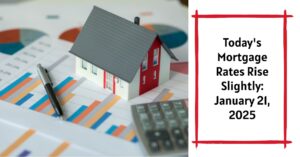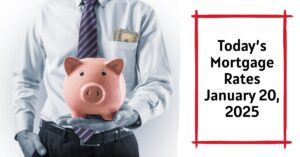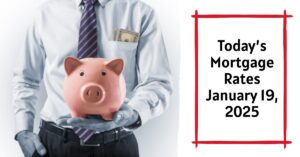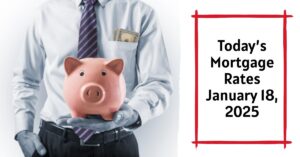Today's mortgage rates on January 21, 2025, have witnessed a modest increase across various loan types, providing crucial insights for potential buyers and current homeowners. Specifically, the average rates for 30-year fixed, 15-year fixed, and adjustable-rate mortgages have risen. If you are looking to enter the housing market or refinance, understanding these rate changes is vital for making informed decisions.
Today's Mortgage Rates Rise Slightly: January 21, 2025 Trends
Key Takeaways
- Current Rates Overview: 30-year fixed at 7.11%, 15-year fixed at 6.41%, 5/1 ARM at 6.87%.
- Recent Trends: Most mortgage rates have experienced a slight increase, reflecting broader economic conditions.
- Refinance Consideration: The 30-year refinance rate is at 7.10%.
- Market Influences: Economic factors such as the Federal Reserve's decisions, inflation, and geopolitical events are affecting mortgage rates.
Overview of Today's Mortgage Rates
As of January 21, 2025, mortgage rates have shown a steady increase, indicating a trend that many are closely watching. The current average rates from Bankrate reveal that different types of mortgages have experienced fluctuations. Here’s a detailed breakdown of last week’s rates compared to the current figures:
| Loan Type | Today's Rate | Last Week's Rate | Change |
|---|---|---|---|
| 30-Year Fixed | 7.11% | 7.10% | +0.01% |
| 15-Year Fixed | 6.41% | 6.39% | +0.02% |
| 5/1 Adjustable Rate Mortgage | 6.87% | 6.58% | +0.29% |
| 30-Year Fixed Jumbo | 7.21% | 7.21% | FLAT |
Detailed Analysis of Mortgage Types
30-Year Fixed-Rate Mortgages Rise Slightly
The average 30-year fixed-rate mortgage (FRM) stands at 7.11%, which indicates a minor increase of 0.01% over the past week. For new borrowers, this means if you secure a mortgage at the current average rate, your monthly principal and interest payments will amount to approximately $672.71 per $100,000 borrowed. Comparing this to last week reveals an increase of $0.68 in your monthly payment, a seemingly small change that can add up over time, particularly when considering the long-term nature of these loans.
The affordability of homeownership is a pertinent issue, and even a slight uptick can push potential buyers to reconsider their budgets. Moreover, this current rate has risen from 7.00% just a month ago, reflecting an ongoing upward trend that homeowners and prospective buyers should keep on their radar.
15-Year Fixed Mortgage Rate Trends Upward
The 15-year fixed mortgage rate, on the other hand, has risen to 6.41%, reflecting an increase of 0.02% from the previous week. This translates into a higher monthly payment of around $866 for every $100,000 borrowed. Such loans are popular among homeowners who wish to pay off their mortgages more quickly, as they typically offer lower interest rates compared to 30-year loans.
However, it’s crucial to note that while a 15-year fixed mortgage may have lower interest rates and payment structures compared to its longer counterpart, a higher monthly burden might not be feasible for everyone.
5/1 Adjustable-Rate Mortgage Rate Moves Up Significantly
The adjustable-rate mortgage (ARM), specifically the 5/1 ARM, reveals a notable increase, now averaging 6.87%, compared to last week’s rate of 6.58%, showing an increase of 0.29%. These loans carry a fixed rate for the first five years, after which the interest rate may adjust annually based on market conditions.
For homeowners who anticipate moving or refinancing within a few years, this type of loan can present cost advantages. Your initial monthly payment would be approximately $657 for each $100,000 borrowed, which can be appealing compared to fixed-rate options. However, the potential for future rate increases presents a risk that must be assessed carefully.
Jumbo Mortgage Interest Rates Flat for the Week
In contrast, jumbo mortgages, which are designed for loans that exceed conforming limits, remain stable at 7.21%. This rate had not changed over the week, but it is notably higher than last month’s average of 7.01%. While a flat rate may signify stability, it’s critical for borrowers in the luxury segment or high-cost areas to remain cautious. Jumbo mortgage holders often face stricter financial scrutiny and higher rates, which can complicate financial planning.
Current 30-Year Mortgage Refinance Rate Climbs
For those evaluating the refinancing landscape, the average 30-year mortgage refinance rate is sitting at 7.10%, marking an increase of 0.02% compared to last week. Should you opt for refinancing at this rate, your monthly payment would be about $672.03 for every $100,000 borrowed. Over time, even slight pivots in rates can lead to significant savings or additional costs, a factor which current mortgage holders should consider, especially if they are pursuing new financing options.
| Loan Type | Today's Refinance Rate | Last Week's Rate | Payment per $100,000 |
|---|---|---|---|
| 30-Year Fixed | 7.10% | 7.02% | $672.03 |
Recommended Read:
Mortgage Rates for January 20, 2025: Trends and Insights
Post-Inauguration Mortgage Rates Outlook: Will They Rise or Fall?
Factors Influencing Mortgage Rates
Understanding what drives mortgage rates is crucial for both borrowers and lenders. A confluence of factors typically influences these rates, some of which include:
- Federal Reserve Policies: The Federal Reserve’s interest rate decisions directly impact mortgage rates. Following a series of rate cuts in 2024, expectations for future monetary policy changes could continue to influence rates.
- Inflation: Mortgage rates are often tied to the movements of inflation. As the cost of goods and services rises, lenders adjust rates accordingly to maintain profit margins and account for increased risk.
- Economic Indicators: Indicators such as employment rates, consumer spending, and GDP growth can all affect mortgage rates. A strong economy usually correlates with higher interest rates.
- Geopolitical Stability: Any geopolitical turmoil can influence investor confidence, impacting the bond markets and subsequently mortgage rates.
- Housing Demand: The balance of supply and demand also plays a significant role in the housing market and can affect mortgage rates. Increased demand for housing can lead lenders to increase rates to counteract risk.
Will Mortgage Rates Go Down in 2025?
Predicting the precise behavior of mortgage rates is inherently complex. Currently, expert consensus suggests that while rates are rising, it is unlikely they will plummet drastically in 2025. The prevailing sentiment is that rates may stabilize within the range of 6% throughout the year, with intermittent spikes above 7%.
As analyst Greg McBride mentions, “The average 30-year fixed mortgage rate will spend most of the year in the 6s, with a short-lived spike above 7 percent, but never getting below 6 percent.” For prospective buyers and those considering refinancing, this insight is essential for planning and decision-making.
Final Thoughts on Today's Mortgage Rates
As we delve into the nuances of today's mortgage rates as of January 21, 2025, it’s clear that while rates have increased slightly, the housing market remains robust with distinct challenges. Many factors continue to influence these rates, necessitating that both potential homebuyers and current homeowners stay informed to make sound financial decisions. Understanding the rate landscape, the driving economic factors, and being prepared for shifts in the market can provide a strategic advantage, whether you're looking to buy a new home or refinance an existing mortgage.
Work with Norada in 2025, Your Trusted Source for
Real Estate Investing
With mortgage rates fluctuating, investing in turnkey real estate
can help you secure consistent returns.
Expand your portfolio confidently, even in a shifting interest rate environment.
Speak with our expert investment counselors (No Obligation):
(800) 611-3060
Recommended Read:
- Mortgage Rates Forecast for the Next 3 Years: 2025 to 2027
- 30-Year Mortgage Rate Forecast for the Next 5 Years
- 15-Year Mortgage Rate Forecast for the Next 5 Years
- Why Are Mortgage Rates Going Up in 2025: Will Rates Drop?
- Why Are Mortgage Rates So High and Predictions for 2025
- NAR Predicts 6% Mortgage Rates in 2025 Will Boost Housing Market
- Mortgage Rates Predictions for 2025: Expert Forecast
- Will Mortgage Rates Ever Be 3% Again: Future Outlook
- Mortgage Rates Predictions for Next 2 Years
- Mortgage Rate Predictions for Next 5 Years
- Mortgage Rate Predictions for 2025: Expert Forecast
- Mortgage Rate Predictions: Why 2% and 3% Rates are Out of Reach
- How Lower Mortgage Rates Can Save You Thousands?
- How to Get a Low Mortgage Interest Rate?
- Will Mortgage Rates Ever Be 4% Again?






